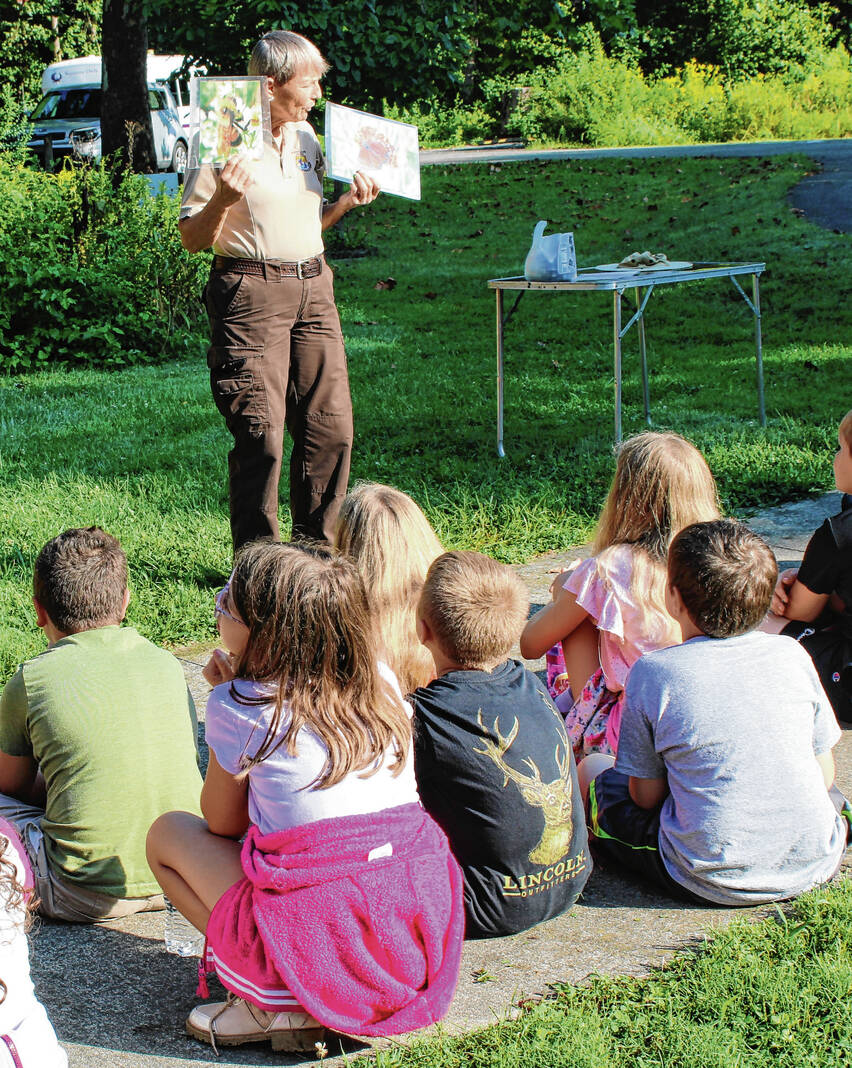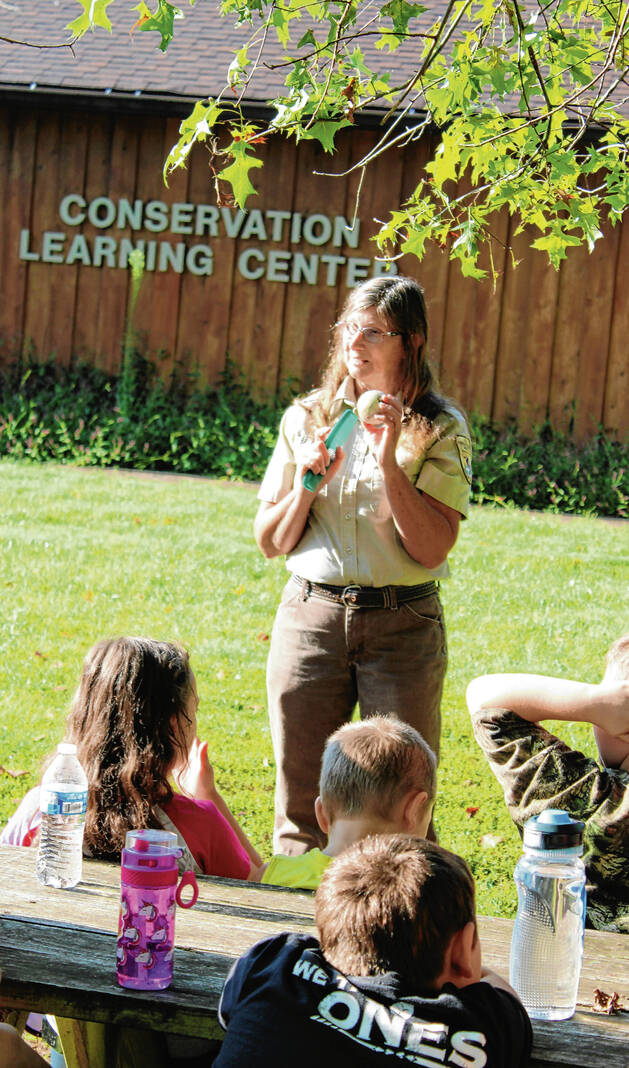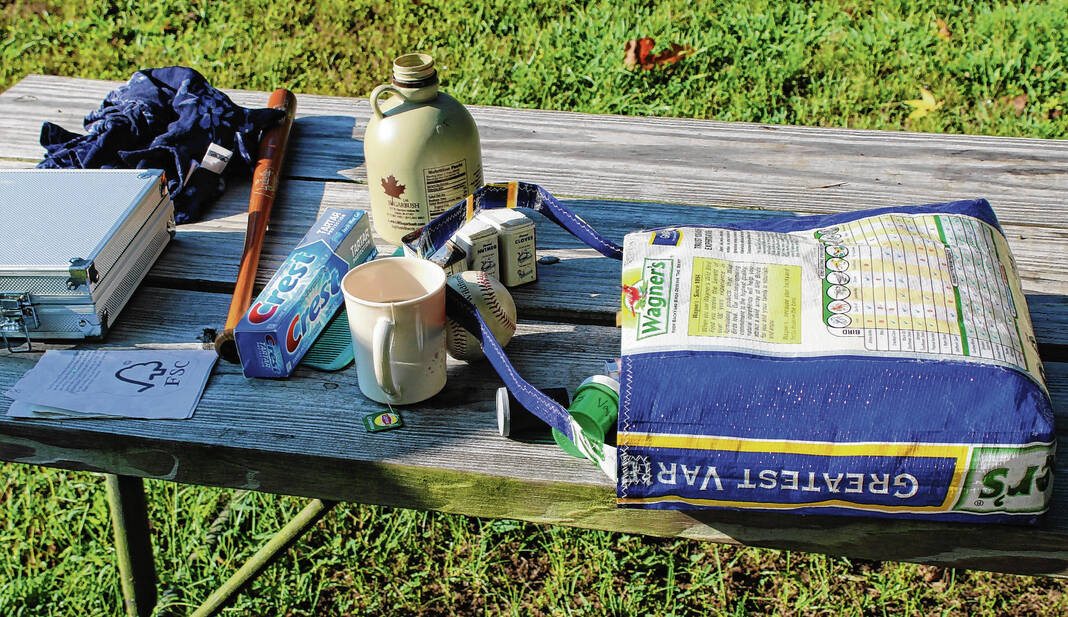Saving the planet, one young mind at a time.
“Trying to,” Terry Ault said of Wednesday’s program at Muscatatuck National Wildlife Refuge in Seymour.
Ault, coordinator of the Jackson County Soil and Water Conservation District, presided over the event that gathered third-graders from schools in Jackson County for an educational field trip.
A variation of the program discussing wildlife, wetlands, trees, recycling and the Jackson County water cycle dates back 27 years. The students received a primer on several aspects of the outdoors that make the environment tick and in the big picture could provide awareness about ways to keep it ticking.
“We’ve got a nice, fun morning of activities,” Ault said in a welcome to four busloads of third-graders from Brownstown and Medora at one session.
Hands-on. Interactive. Outdoors in the sun instead of indoors in a classroom. Rotating through five stations, the program piqued the enthusiasm of the youngsters, who were followed in another session by students from Seymour-Jackson Elementary School, Sandy Creek Christian Academy, St. Ambrose Catholic School and St. John’s Sauers Lutheran School.
More than 300 third-graders were included, though in pre-COVID-19 days, the program hosted 600-some students, Ault said.
Although others may be surprised by the popularity of the species, thinking kids may go “Eew,” Muscatatuck Park Ranger Donna Stanley has learned youngsters of this age, around 8, by a great majority wave hands in the air energetically when asked, “Who likes snakes?”
Stanley, who ran the wildlife station, said the other reaction would likely have proven true for adults.
“The parents, maybe no,” Stanley said. “They (kids) haven’t learned to be afraid of them.”
One Medora student, Korbin Brock, said he had an affinity for slithery things.
“I just like snakes,” he said. “They can be colorful.”
The students may have been too young to process the recent public information about the decline by millions of the monarch butterfly, but Stanley touched on that.
“Some years, we see a lot of them, and some years, we don’t see many,” she said.
When Stanley requested suggestions on how people could do more to help the butterflies, one girl said, “You can reduce the use of bug spray.” Stanley called that an excellent idea.
The real lesson of the wildlife stop centered around habitat. When students were asked if they knew what habitat was, one little girl piped up with, “It’s a place where an animal lives.” Bingo.
In one exercise, the children imitated otters foraging for food. They picked up designated cards representing favorite foods with their “paws.” If an otter did not gather 20 points worth, Stanley had a sobering message – they would not survive.
At the tree station, Sandy Derringer, a park ranger at Big Oaks National Wildlife Refuge in Madison, seemed to be speaking to the youthful converted. Their hands shot into the air when she asked, “How many of you think it’s bad to cut down trees?”
Derringer covered the science of how trees produce oxygen but also dipped into a bag of tricks almost like a magician to show products containing wood from trees.
Some were obvious, such as a little baseball bat, as was her listing of home building and furniture making. Some were items thought of as being at all dependent on wood. Derringer referenced cinnamon.
“Do you know you’re eating a tree?” she said. “The inner part of a baseball is cork.”
Tree byproducts go into lipstick and makeup, too. There were skeptics about toothpaste.
“There are products where it gives you the flavor to make it taste sweet,” she said.
Derringer said it is clearly necessary to cut down some trees to make things, but it is not good to cut down too many.
She introduced the concept of being sustainable even if the kids could barely pronounce it. It may be college graduates have trouble comprehending rules on who can legally cut down a tree in Indiana. To be certified as a sustainable tree, Derringer said there are “1,000 pages of rules.” That reading level may be over the heads of the third-graders.
Richard Beckort with Purdue Extension Jackson County had the challenging task of making clear the importance of wetlands.
Wetlands, Beckort said, “hold water for a long time. It can be anything that holds water in nature.” Such as a river or a lake. To illustrate, Beckort whipped out sponges for youngsters to hold because they can hold liquids for considerable time.
While students can go to the water fountain if thirsty, raccoons and other wild critters need other sources, Beckort said. Wetlands provide water for the animals.
Teachers provide a heads-up on what to expect and how to behave for the third-graders.
Medora teacher Carrie Brewer said her class has been studying sustainable food sources, and she tipped the kids off that they would hear about animals and wetlands.
“Anything that gets them outside gets them excited,” Brewer said. “It’s a great program.”
Macey Stuckwisch with a Brownstown Elementary School class said a strength of the program is its interactive nature.
“They definitely learn from the hands-on part,” she said.
Co-instructors Debbie Hackman, executive director of the Jackson County Recycling District, and Bernie Bryant, an environmental educator for the Seymour Department of Public Works, took that to heart. For their recycling program, the only one conducted indoors in the visitor center, they came loaded with stuff.
Each child was given an object of a different kind to hold — cans made of metal, bottles made of glass, boxes made of cardboard, bottles made of plastic — and learned Styrofoam related to no-nos for recycling.
Before one group departed, Bryant commented perhaps among them there might be “a cool person” who someday will come up with new recycling ideas and also, incidentally, contribute to saving the planet.




